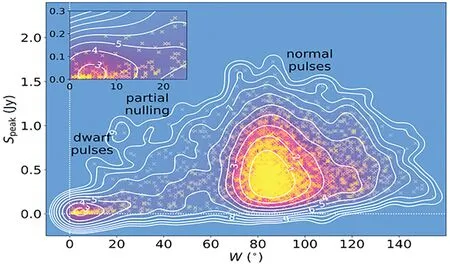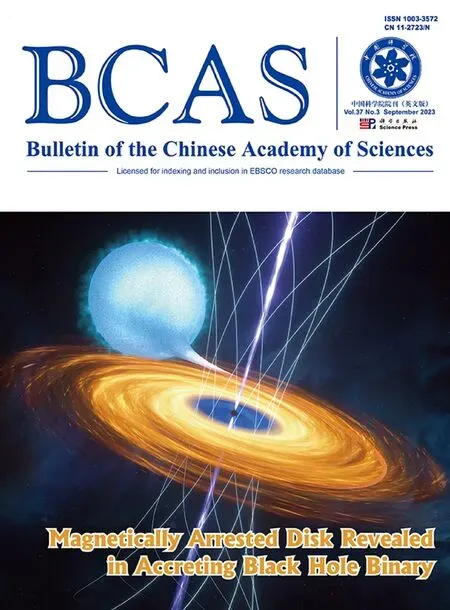FAST Detects Distinct “Dwarf” Pulses during Nulling State of a Pulsar
Using the Five-hundred-meter Aperture Spherical radio Telescope (FAST), a research team led by Prof.HAN Jinlin from the National Astronomical Observatories of the Chinese Academy of Sciences (NAOC) has detected distinct “dwarf pulses”from an aged pulsar PSR B2111+46, and studied the radio emission in unprecedented details and probed the elusive physics in the magnetosphere.
This study was published inNature Astronomyon Aug.17.
Pulsars generally emit periodic radio signals.However, some aged pulsars occasionally quench for some periods, a phenomenon known as “pulse nulling.”Possible mechanisms underlying this quiescence might include two different scenarios: the magnetosphere might fail to produce the high-energy particles due to improper conditions or changes in the magnetic field structure and radiation region, and/or the area of magnetosphere for particle creation is then flooded by plasma produced in other areas.Scientists wonder if the magnetosphere is in a very different physical state when the emission ceases,however, their inquiries are frustrated by the absence of observational data itself during the nulling state, because it is impossible to probe the physical state of the pulsar’s magnetosphere when radiation is quenched.
The discovery of the new population of dim emission pulses surprisingly offers a unique probe into the physical processes and the emission region during the quenched states of the magnetosphere, and this,might hint on some inherent mechanisms driving the powerhouse of an aged pulsar – a long-sought-after puzzle.
PSR B2111+46 is a relatively old pulsar, and scientists have long known that the emission from this pulsar often nulls for some periods.However, dozens of unusually weak, very narrow pulses – previously unobserved – were detected during ordinary nulling periods when it was serendipitously observed on August 24, August 26 and September 17, 2020 by FAST, as part of its observations for the Galactic Plane Pulsar Snapshot survey, a major key project of this National Science Facility to hunt pulsars.
To verify this new kind of emission state, the researchers observed this pulsar again for two hours again on March 8, 2022.“Finally, we picked out 175 such narrow, weak pulses,” said Dr.CHEN Xue, first author of the study.According to Dr.CHEN, such pulses stand out from normal ones in terms of pulse width and energy as a distinct population, and thus have been named “dwarf pulses”.
Whereas normal individual pulses emit radiation through a “thunderstorm” of particles produced by copious discharges in regularly formed gaps near the pulsar’s magnetic poles, dwarf pulses are produced by one or a few “raindrops” of particles generated by pair production in a fragile gap of this near-death pulsar.
These sporadic, weak, and narrow pulses constitute a new radiation state independent of normal pulses,and such pulses often exhibit a rare reversed spectrum,i.e., they have much stronger emission at higher radio frequencies, something that is very rarely detected in such a distinguished timescale from astronomical sources.
The team analyzed the polarization angles of dwarf pulses to understand the pulsar’s magnetosphere structure during the nulling state.They found that the dwarf pulses kept the same polarization angle distribution as normal ones, and hence inferred that the magnetic-filed configuration does not change at this newly detected transition phase to the completely nulling phase.
Further, they also tried to measure the propagation effects of the emissions and examine the plasma properties in the pulsar’s magnetosphere.Comparing the propagation characteristics of the dwarf pulses during the nulling state with that of normal pulses, they found only a “marginally significant” shift in pulse emission phases.This implies, the authors explained, not only no change in the magnetic-field configuration in the emission region but also only a slight change or no change in the density of the magnetospheric background plasma during the nulling state, compared with that for the normal emission state.

Dwarf pulses from pulsar B2111+46 exhibit distinct differences in pulse width and radiation energy compared to normal pulses, suggesting a new emission state different from ordinary pulsar radiation.(Image by NAOC)
“The properties of such dwarf pulses would be hard to measure for other radio telescopes in comparison with FAST,” said Prof.HAN, “and measurements of such a new population of dwarf pulses reveal that the magnetic field structure for the pulsar radiation remains unchanged even when the radiation is almost ceased.”
“In fact, a smaller number of dwarf pulses have also been detected from a few other pulsars,” said Ms.YAN Yi, co-first author of the study.Given this, the team proposed that dwarf pulses are probably a common phenomenon for old nulling pulsars, and become more visible as a distinct, very weak emission mode once observed with a highly sensitive instrument as FAST.
“Detailed studies of such a dwarf pulse population could uncover some mysteries of unknown pulsar radiation processing and reveal the extreme plasma state in the pulsar magnetosphere,” added YAN.
This paper can be accessed at https://www.nature.com/articles/s41550-023-02056-z
 Bulletin of the Chinese Academy of Sciences2023年3期
Bulletin of the Chinese Academy of Sciences2023年3期
- Bulletin of the Chinese Academy of Sciences的其它文章
- Could Gut Bacteria Hold a Cure for Sepsis?
- Looking into the Tissue Adjacent to Tumors
- Daya Bay Collaboration Awarded 2023 High Energy and Particle Physics Prize by European Physical Society
- Largest Optical Time-domain Survey Telescope in Northern Hemisphere Goes into Operation
- CAS Paleogeneticist Awarded UNESCO Prize
- “Magnetically Arrested Disk”Revealed by Multiwavelength Observation
